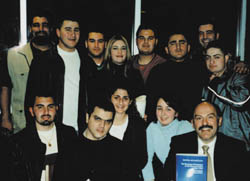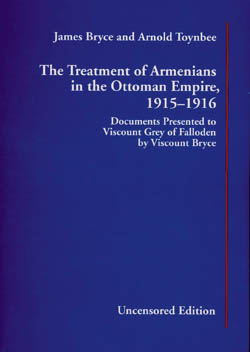John Jabagchourian
Editor
Following the recent news of the French government’s official recognition of the Armenian Genocide and the adoption of similar resolutions in other European nations, British archival historian, Ara Sarafian, visited California State University, Fresno to speak about “Britain and the Armenian Genocide” in an evening lecture on February 20.

Ara Sarafian, front row, second from left, with Armenian Students Organization members after the lecture. Sarafian spoke on the British government’s role in acknowledging and publicizing the Genocide while it was occurring in 1915 but their reluctance to recognize the Genocide today.
“England is both a primary witness as well as a denier,” Sarafian said.
In 1916, the British Parliament published The Treatment of Armenians in the Ottoman Empire 1915-16. Known as the British Blue Book, it was a series of regional eyewitness narratives that document the violations of human rights by the Ottoman Turkish government and demonstrate a common sequence of events that uncovers the plan to exterminate Armenians within the region.
Compiled by James Bryce and Arnold Toynbee, The Treatment of Armenians in the Ottoman Empire 1915-16 was the first systematic thesis to articulate that the Armenian Genocide was planned and organized by the Ottoman Turkish government.
However, in a position paper by the British Government establishing a Genocide and Holocaust day, the government did not want to consider genocides before 1939, only the Holocaust. Year after year there had been no mention of the Armenian Genocide during the Genocide and Holocaust day activities.
Sarafian said that attitudes are changing and the push for recognizing the Genocide in Britain has been generally successful. Recently during a government-sponsored Holocaust and Genocide day, Sarafian said that the BBC made a public acknowledgement of the Armenian Genocide, which can be considered as de facto recognition.
Movement is also being made with the re-release of The Treatment of Armenians in the Ottoman Empire 1915-16 at the House of Lords last December. Sarafian is editor of the republished edition, which is an uncensored version of the original released in 1916. This edition reveals the names of those reporting the injustices occurring in the Ottoman Empire during 1915-1916. The names were not mentioned in the original to protect those who were still in the area and were published separately as a key for officials only.

The Treatment of Armenians in the Ottoman Empire, 1915-1916. By Viscount Bryce. The Uncensored Edition. Republished by the Gomidas Institute.
The release of the book is not without opposition. Many of the Turkish immigrants in England have petitioned to prohibit the re-release. Sarafian pointed out that there are only about 15 thousand Armenians living in England among 200 thousand Turkish people plus 2 million Muslims. Sarafian said that the Armenians in England cannot win a letter writing campaign and must focus their efforts on intellectual arguments and documented evidence that exists. The release of the Blue Book demonstrates these efforts. All information provided in the Blue Book is cataloged and can be traced to the original source predominantly located in the United States National Archives.
Sarafian is currently editor of Gomidas Institute Books and co-editor of Armenian Forum: A Journal of Contemporary Affairs. He has extensive experience doing research in the archives of Armenia, London, Athens, Boston, the U.S. National Archives, and the Prime Ministry Archives of Istanbul.
Sarafian has edited a series on United States Official Documents on the Armenian Genocide, and the recently published Days of Tragedy: Personal Experiences in Harpoot 1915-1917. He has also participated in many conferences: “The Famine of 1880-1881 and the Civic Response in Van,” at the Conference on Van-Vaspuragan at UCLA; “The Conversion of Armenian Women and Children,” at the International Conference on Genocide, Religion, and Modernity at the United States Holocaust Memorial Museum, Washington D.C.; and “The Testimony of Ambassador Morgenthau on the Armenian Genocide: the Morgenthau Diaries 1913-1916,” at the Armenian Genocide: Political and Historical Controversies Conference at Drew University.
The lecture was co-sponsored by the Armenian Students Organization and Armenian Studies Program of Fresno State.
The program was funded, in part, by the Associated Students at Fresno State.
 Hye Sharzhoom Armenian Action
Hye Sharzhoom Armenian Action